Introduction
This page presents how ITS-Tools do cope efficiently with the ReachabilityCardinality examination face to the other participating tools. In this page, we consider «Surprise» models.
The next sections will show chart comparing performances in termsof both memory and execution time.The x-axis corresponds to the challenging tool where the y-axes represents ITS-Tools' performances. Thus, points below the diagonal of a chart denote comparisons favorables to the tool whileothers corresponds to situations where the challenging tool performs better.
You might also find plots out of the range that denote the case were at least one tool could not answer appropriately (error, time-out, could not compute or did not competed).
ITS-Tools versus LoLa
Some statistics are displayed below, based on 278 runs (139 for ITS-Tools and 139 for LoLa, so there are 139 plots on each of the two charts). Each execution was allowed 1 hour and 16 GByte of memory. Then performance charts comparing ITS-Tools to LoLa are shown (you may click on one graph to enlarge it).
| Statistics on the execution | ||||||
| ITS-Tools | LoLa | Both tools | ITS-Tools | LoLa | ||
| Computed OK | 8 | 74 | 55 | Smallest Memory Footprint | ||
| Do not compete | 0 | 9 | 0 | Times tool wins | 25 | 112 |
| Error detected | 3 | 0 | 0 | Shortest Execution Time | ||
| Cannot Compute + Time-out | 72 | 0 | 1 | Times tool wins | 27 | 110 |
On the chart below, ![]() denote cases where
the two tools did computed a result without error,
denote cases where
the two tools did computed a result without error, ![]() denote the cases where at least one tool did not competed,
denote the cases where at least one tool did not competed,
![]() denote the cases where at least one
tool computed a bad value and
denote the cases where at least one
tool computed a bad value and ![]() denote the cases where at least one tool stated it could not compute a result or timed-out.
denote the cases where at least one tool stated it could not compute a result or timed-out.
ITS-Tools versus LTSMin
Some statistics are displayed below, based on 278 runs (139 for ITS-Tools and 139 for LTSMin, so there are 139 plots on each of the two charts). Each execution was allowed 1 hour and 16 GByte of memory. Then performance charts comparing ITS-Tools to LTSMin are shown (you may click on one graph to enlarge it).
| Statistics on the execution | ||||||
| ITS-Tools | LTSMin | Both tools | ITS-Tools | LTSMin | ||
| Computed OK | 8 | 75 | 55 | Smallest Memory Footprint | ||
| Do not compete | 0 | 9 | 0 | Times tool wins | 57 | 81 |
| Error detected | 3 | 0 | 0 | Shortest Execution Time | ||
| Cannot Compute + Time-out | 73 | 0 | 0 | Times tool wins | 45 | 93 |
On the chart below, ![]() denote cases where
the two tools did computed a result without error,
denote cases where
the two tools did computed a result without error, ![]() denote the cases where at least one tool did not competed,
denote the cases where at least one tool did not competed,
![]() denote the cases where at least one
tool computed a bad value and
denote the cases where at least one
tool computed a bad value and ![]() denote the cases where at least one tool stated it could not compute a result or timed-out.
denote the cases where at least one tool stated it could not compute a result or timed-out.
ITS-Tools versus Tapaal(PAR)
Some statistics are displayed below, based on 278 runs (139 for ITS-Tools and 139 for Tapaal(PAR), so there are 139 plots on each of the two charts). Each execution was allowed 1 hour and 16 GByte of memory. Then performance charts comparing ITS-Tools to Tapaal(PAR) are shown (you may click on one graph to enlarge it).
| Statistics on the execution | ||||||
| ITS-Tools | Tapaal(PAR) | Both tools | ITS-Tools | Tapaal(PAR) | ||
| Computed OK | 14 | 59 | 49 | Smallest Memory Footprint | ||
| Do not compete | 0 | 9 | 0 | Times tool wins | 50 | 72 |
| Error detected | 3 | 0 | 0 | Shortest Execution Time | ||
| Cannot Compute + Time-out | 57 | 6 | 16 | Times tool wins | 57 | 65 |
On the chart below, ![]() denote cases where
the two tools did computed a result without error,
denote cases where
the two tools did computed a result without error, ![]() denote the cases where at least one tool did not competed,
denote the cases where at least one tool did not competed,
![]() denote the cases where at least one
tool computed a bad value and
denote the cases where at least one
tool computed a bad value and ![]() denote the cases where at least one tool stated it could not compute a result or timed-out.
denote the cases where at least one tool stated it could not compute a result or timed-out.
ITS-Tools versus Marcie
Some statistics are displayed below, based on 278 runs (139 for ITS-Tools and 139 for Marcie, so there are 139 plots on each of the two charts). Each execution was allowed 1 hour and 16 GByte of memory. Then performance charts comparing ITS-Tools to Marcie are shown (you may click on one graph to enlarge it).
| Statistics on the execution | ||||||
| ITS-Tools | Marcie | Both tools | ITS-Tools | Marcie | ||
| Computed OK | 12 | 24 | 51 | Smallest Memory Footprint | ||
| Do not compete | 0 | 0 | 0 | Times tool wins | 61 | 26 |
| Error detected | 3 | 0 | 0 | Shortest Execution Time | ||
| Cannot Compute + Time-out | 23 | 14 | 50 | Times tool wins | 56 | 31 |
On the chart below, ![]() denote cases where
the two tools did computed a result without error,
denote cases where
the two tools did computed a result without error, ![]() denote the cases where at least one tool did not competed,
denote the cases where at least one tool did not competed,
![]() denote the cases where at least one
tool computed a bad value and
denote the cases where at least one
tool computed a bad value and ![]() denote the cases where at least one tool stated it could not compute a result or timed-out.
denote the cases where at least one tool stated it could not compute a result or timed-out.
ITS-Tools versus PeCan
Some statistics are displayed below, based on 278 runs (139 for ITS-Tools and 139 for PeCan, so there are 139 plots on each of the two charts). Each execution was allowed 1 hour and 16 GByte of memory. Then performance charts comparing ITS-Tools to PeCan are shown (you may click on one graph to enlarge it).
| Statistics on the execution | ||||||
| ITS-Tools | PeCan | Both tools | ITS-Tools | PeCan | ||
| Computed OK | 43 | 28 | 20 | Smallest Memory Footprint | ||
| Do not compete | 0 | 9 | 0 | Times tool wins | 50 | 41 |
| Error detected | 0 | 37 | 3 | Shortest Execution Time | ||
| Cannot Compute + Time-out | 50 | 19 | 23 | Times tool wins | 56 | 35 |
On the chart below, ![]() denote cases where
the two tools did computed a result without error,
denote cases where
the two tools did computed a result without error, ![]() denote the cases where at least one tool did not competed,
denote the cases where at least one tool did not competed,
![]() denote the cases where at least one
tool computed a bad value and
denote the cases where at least one
tool computed a bad value and ![]() denote the cases where at least one tool stated it could not compute a result or timed-out.
denote the cases where at least one tool stated it could not compute a result or timed-out.
ITS-Tools versus Tapaal(EXP)
Some statistics are displayed below, based on 278 runs (139 for ITS-Tools and 139 for Tapaal(EXP), so there are 139 plots on each of the two charts). Each execution was allowed 1 hour and 16 GByte of memory. Then performance charts comparing ITS-Tools to Tapaal(EXP) are shown (you may click on one graph to enlarge it).
| Statistics on the execution | ||||||
| ITS-Tools | Tapaal(EXP) | Both tools | ITS-Tools | Tapaal(EXP) | ||
| Computed OK | 9 | 74 | 54 | Smallest Memory Footprint | ||
| Do not compete | 0 | 9 | 0 | Times tool wins | 43 | 94 |
| Error detected | 3 | 2 | 0 | Shortest Execution Time | ||
| Cannot Compute + Time-out | 73 | 0 | 0 | Times tool wins | 52 | 85 |
On the chart below, ![]() denote cases where
the two tools did computed a result without error,
denote cases where
the two tools did computed a result without error, ![]() denote the cases where at least one tool did not competed,
denote the cases where at least one tool did not competed,
![]() denote the cases where at least one
tool computed a bad value and
denote the cases where at least one
tool computed a bad value and ![]() denote the cases where at least one tool stated it could not compute a result or timed-out.
denote the cases where at least one tool stated it could not compute a result or timed-out.
ITS-Tools versus Tapaal(SEQ)
Some statistics are displayed below, based on 278 runs (139 for ITS-Tools and 139 for Tapaal(SEQ), so there are 139 plots on each of the two charts). Each execution was allowed 1 hour and 16 GByte of memory. Then performance charts comparing ITS-Tools to Tapaal(SEQ) are shown (you may click on one graph to enlarge it).
| Statistics on the execution | ||||||
| ITS-Tools | Tapaal(SEQ) | Both tools | ITS-Tools | Tapaal(SEQ) | ||
| Computed OK | 11 | 65 | 52 | Smallest Memory Footprint | ||
| Do not compete | 0 | 9 | 0 | Times tool wins | 47 | 81 |
| Error detected | 3 | 0 | 0 | Shortest Execution Time | ||
| Cannot Compute + Time-out | 63 | 3 | 10 | Times tool wins | 54 | 74 |
On the chart below, ![]() denote cases where
the two tools did computed a result without error,
denote cases where
the two tools did computed a result without error, ![]() denote the cases where at least one tool did not competed,
denote the cases where at least one tool did not competed,
![]() denote the cases where at least one
tool computed a bad value and
denote the cases where at least one
tool computed a bad value and ![]() denote the cases where at least one tool stated it could not compute a result or timed-out.
denote the cases where at least one tool stated it could not compute a result or timed-out.


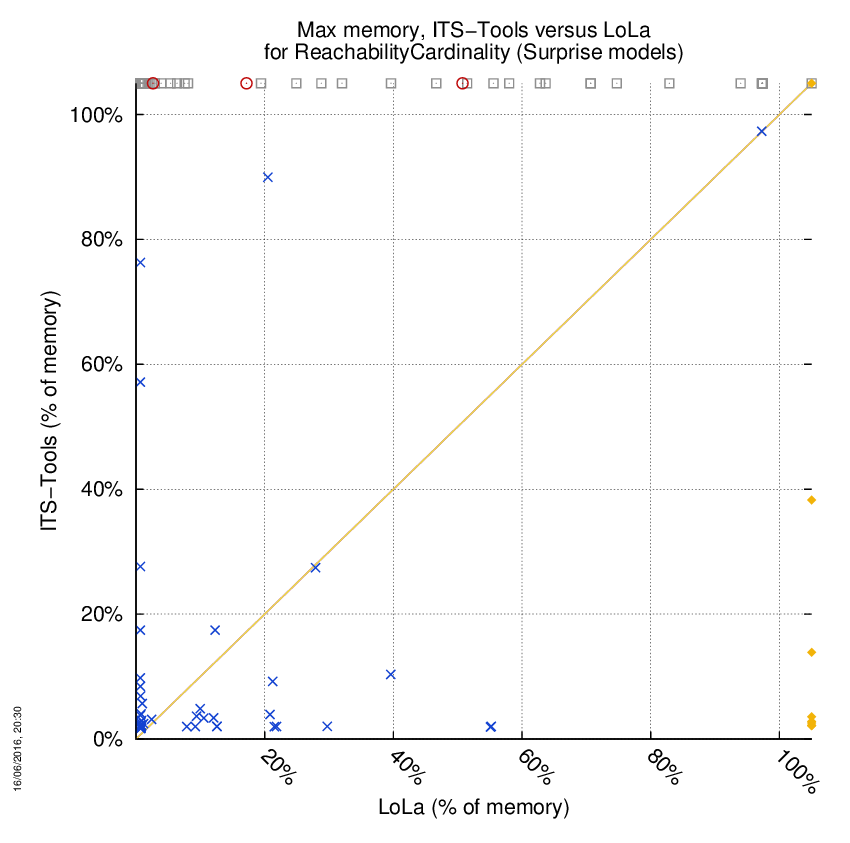
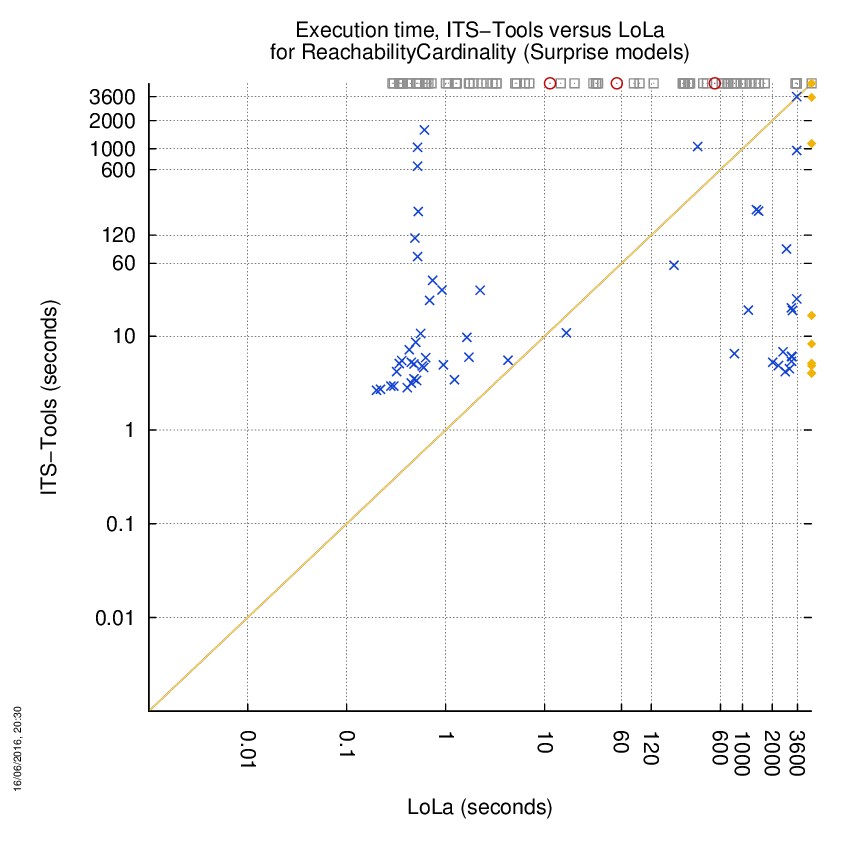
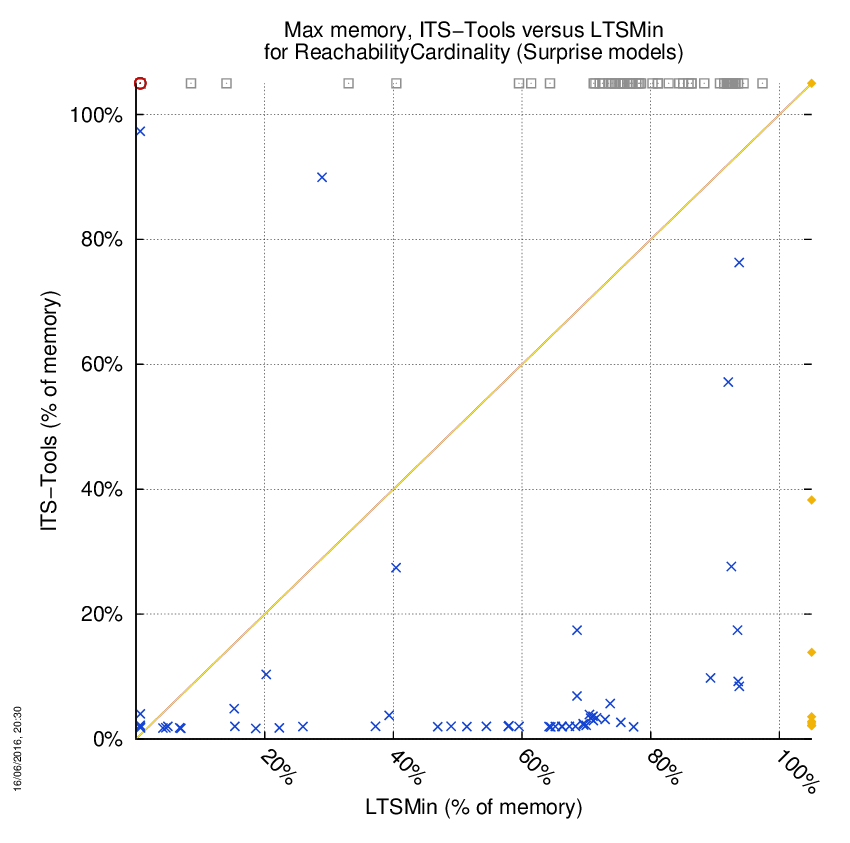
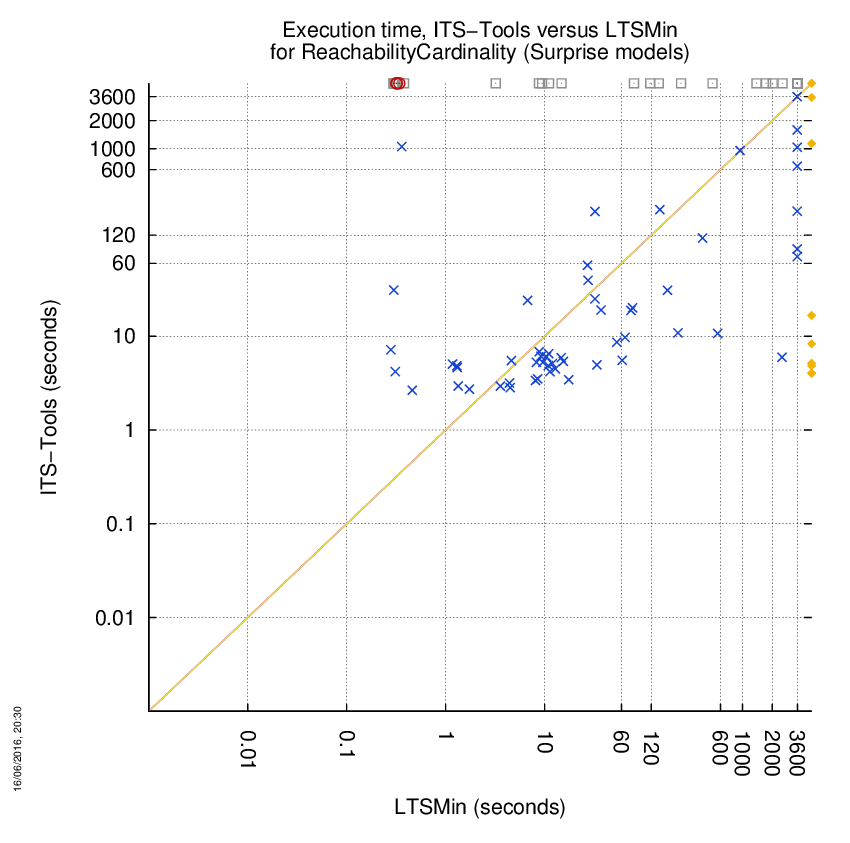
_ReachabilityCardinality.png)
_ReachabilityCardinality.png)
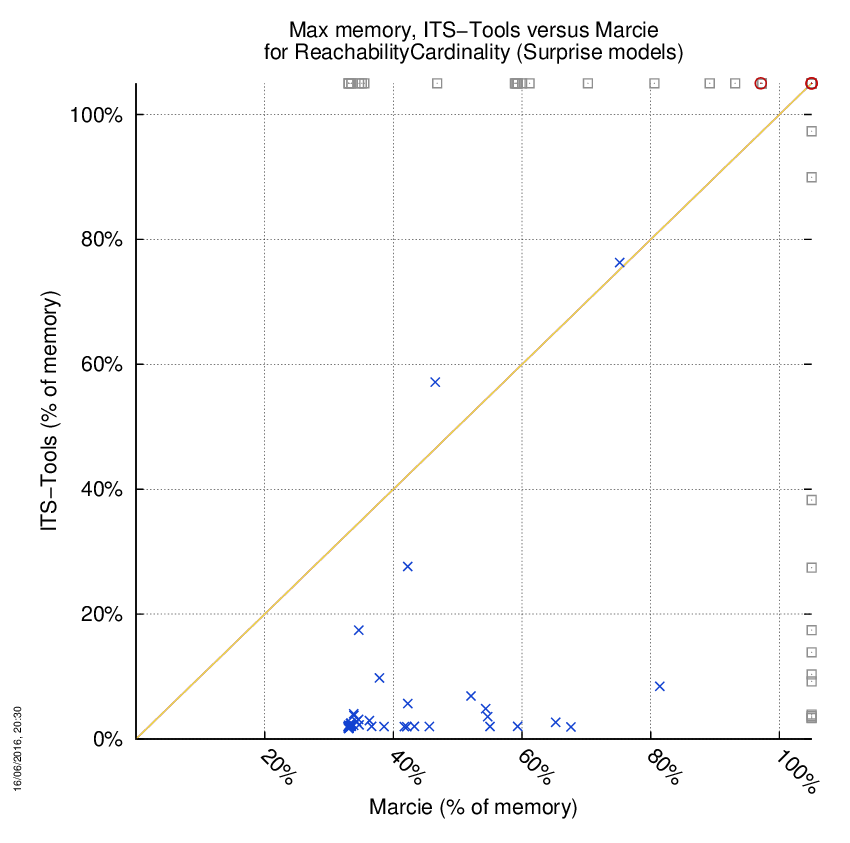
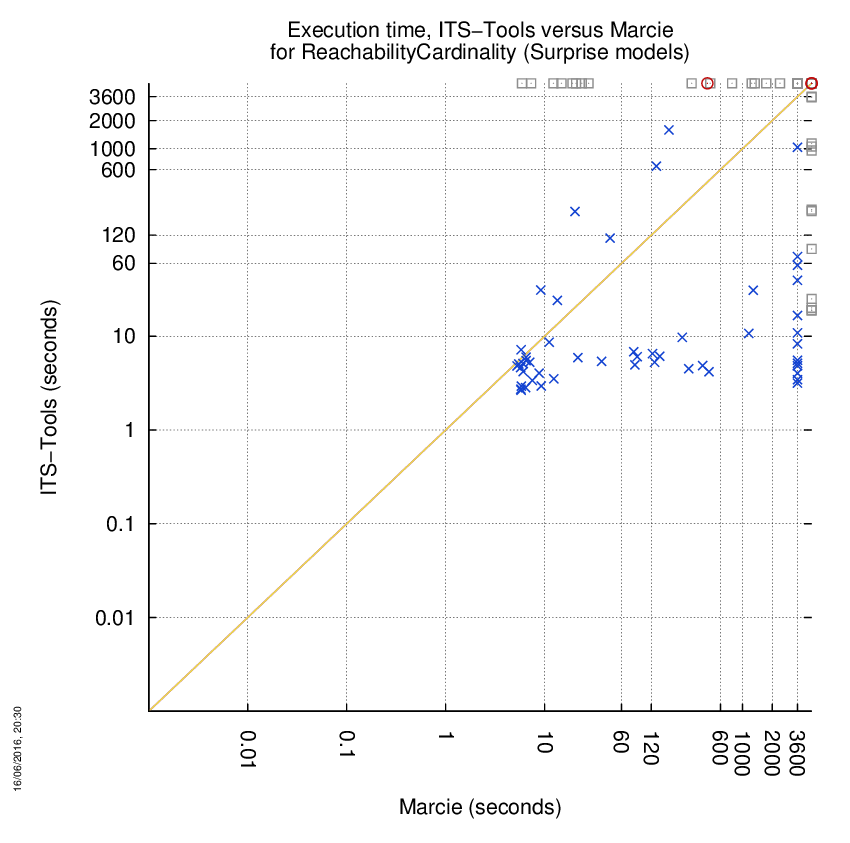
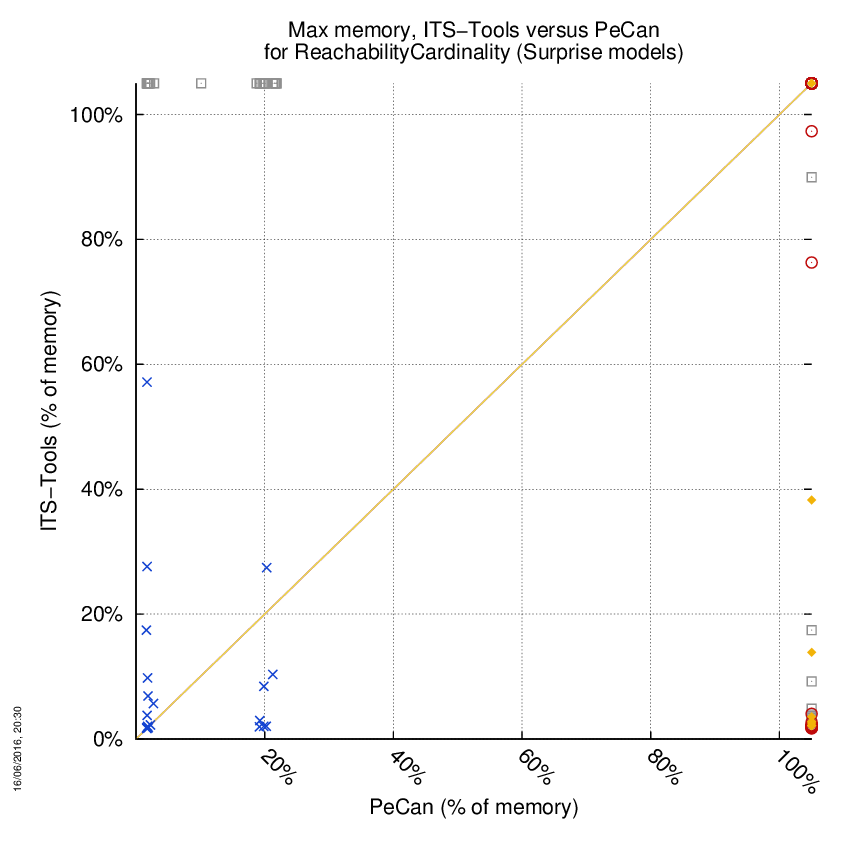
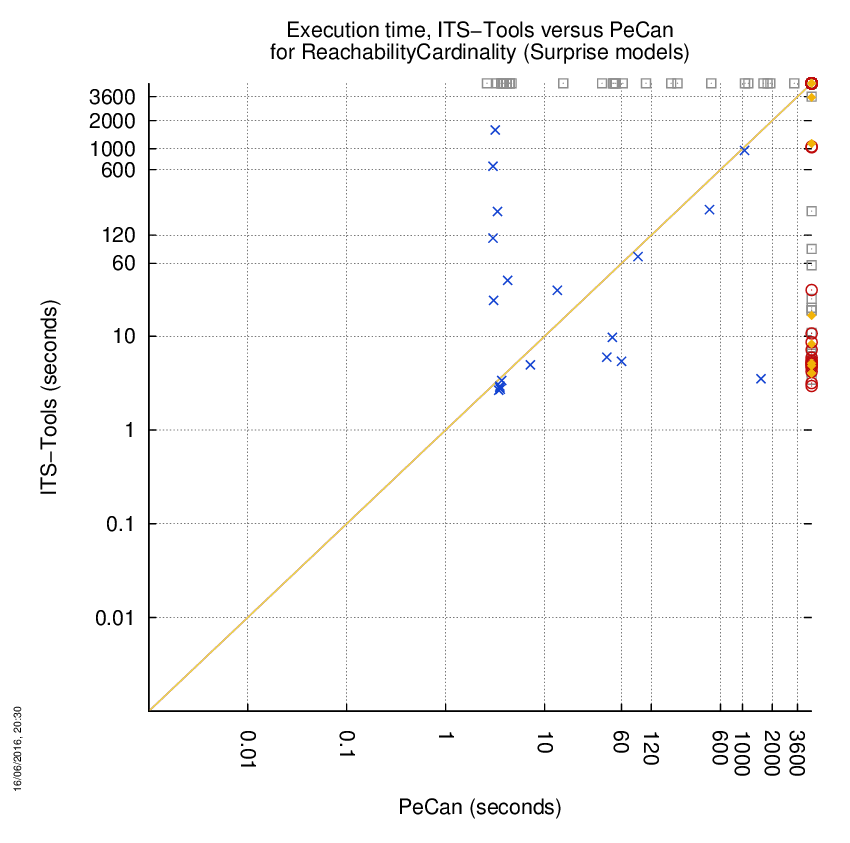
_ReachabilityCardinality.png)
_ReachabilityCardinality.png)
_ReachabilityCardinality.png)
_ReachabilityCardinality.png)